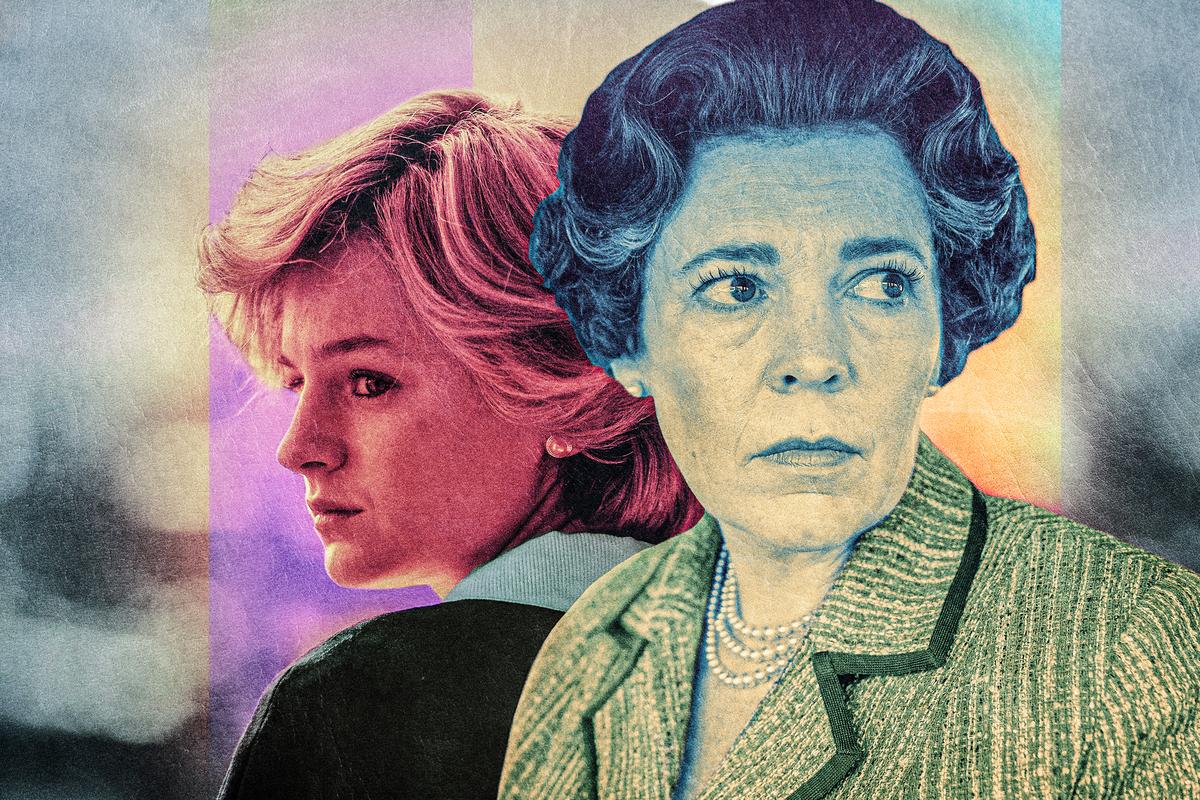
The Crown is good this year. I’m a little surprised to be able to say this. Over the past three seasons, the show’s middlebrow-Wiki-soap-opera approach to storytelling—lavish production values, punishingly straightforward symbolism, fine actors feeling for the humanity in dialogue stuffed with exposition—had started to drive me toward positively anti-monarchical sentiments. I’ve always been excessively and irrationally interested in the British royal family, but too often watching The Crown was like watching a version of Downton Abbey where every third scene was a lecture about the economic forces driving up the price of domestic labor, or like watching a version of Star Wars where someone kept saying, “It seems war has finally come to our home in the stars.” Episodes strained to impose crisp three-act plot structures on complex historical events, then clobbered you with those structures’ portentousness. At its worst, The Crown’s commitment to conflating the private lives of the royals with the state of British society could have made them seem accidentally godlike, as though, say, the queen’s anxiety about motherhood had caused a nationwide mining strike to break out.
The prospect of a fourth season of this did not fill me with glee, or with whatever emotion The Crown wants you to be filled with. (Is there an emotion that corresponds to “flipping through a supermarket tabloid, but very, very solemnly”?) And in fact, the 10 new episodes arriving on Netflix this week do retain many of the show’s worst qualities. There’s still a strong general vibe of, like:
PRINCESS DIANA: Charles, our marriage is crumbling because you don’t understand me—don’t understand how my charisma and human touch have breathed new life into a monarchy that, while well-meaning, is dangerously unsuited to the new media environment of the late 1970s–early 1980s. [Weeps, smashes plate.]
PRINCE CHARLES: Unemployment is skyrocketing under the draconian economic policies of recently elected Prime Minister Margaret Thatcher, but the true casualty of the 18.7 percent inflation rate is our hearts.
[A magnificent stag appears on the hill above them. The stag kneels to Diana.]
DIANA: That represents Britain. [Weeps.]
CHARLES: My family have always enjoyed hunting at our various estates, such as Balmoral, the castle constructed in the 1850s in Aberdeenshire, Scotland, where we also keep grouse.
And yet for all that, the show is good now. Partly this is a matter of timing. The last season of The Crown had the burden of leading us through some relatively unsplashy middle years in the reign and life of Queen Elizabeth, played here by Olivia Colman, who took over from Claire Foy after Season 2. (In the new season, the show’s fourth, Foy returns briefly in a flashback.) With historical plots like “Princess Margaret tries to persuade Lyndon B. Johnson to help Britain obtain a financial bailout” and personal plots like “Elizabeth wishes she had more time to spend with her racehorses,” even the best TV minds could only do so much. The producers could, it’s true, be charged with some [extremely Queen Mother voice] rather curious decisions about what to include and what to omit. Electing to skip over the 1974 kidnapping attempt on Princess Anne, which led to a gunfight on a London street, remains a mystifying self-own, particularly given that Erin Doherty’s electrically starchy Anne is one of the delights of the series. Why wouldn’t you want to film this supremely Not Here for Your Bullshit princess telling off the armed men who have just shot her bodyguard? On the whole, though, one had to acknowledge that the 1970s were not entirely The Crown’s fault.
Now, though, we’re coming up to the good bits—which is to say, to the epoch of sustained personal tragedy, political turmoil, and anguish that befell this group of real people, most of whom are still alive. (Thinking about The Crown will make you feel like a moral vampire; still, contentment and stability never made for great TV.) The arrivals of Thatcher (Gillian Anderson, mannered, raspy, helmet-haired, and hugely watchable) and of Princess Diana (Emma Corrin, on whom more in a second) bring us up to something like the modern era in media and politics. The main plots here are the material much of The Crown’s audience remembers—the stuff we don’t have to Google afterward.
And even the B-plots this season are dramatic enough not to be swamped by the show’s omnipresent grandiosity. Prince Charles, at one point, is literally trapped in an avalanche. The IRA—spoiler alert, I guess, though that’s an odd warning to issue about a historical event that predates both The Empire Strikes Back and the birth of Meghan Markle—blows up the lobster boat carrying family mainstay Dickie Mountbatten (Charles Dance, somehow one-upping his death as Tywin Lannister). At first, I was amazed that the producers skipped the famous 1981 incident in which a man opened fire on the queen as she rode by on horseback during a parade—it turned out he was shooting blanks, though no one knew this at the time—but after a whole episode devoted to the later incident in which a man broke into Buckingham Palace and surprised the queen in her bedroom, it made more sense. So many deranged commoners, so little time.
But it isn’t only the chronology that makes this season an improvement. As far as its point of view goes, The Crown has always struggled to get beyond a certain glossy political affectlessness. It knows there are poor people and it wants to be on their side, but it’s also driven by imperatives of sentimentality and nostalgia that keep it from questioning the aristocratic status quo too pointedly. I guess it goes without saying that you don’t make a show called The Crown if you want to plump for dialectical materialism. Or if you do, you don’t get a production budget the size of a small Soviet republic’s GDP for it.
The onset of the Thatcher era, however, and everything it brings with it—collapsing bureaucracy, bleak industrial estates, post-punk music, predatory Falklands War nationalism, the rage and despair in the dole lines— finally gives the series a visible and palpable register of historical pain. For the first time, the show can depict ordinary misery without lapsing into flimsy costume-drama reenactment of the “these old-timey miners are angry” vein. That is, there is finally something on the other side of the glass to stand in significant contrast to the splendor of the monarchy, and to throw the queen’s role into a meaningful crisis. Which side is she on?
Which side—that’s the question posed by the episode in which Michael Fagan, an unemployed, working-class painter-decorator, climbs an unguarded fence, scales a drainpipe on the palace wall, and ends up confronting the queen in her bedchamber. Most of the episode follows him, not her; we see him waking up in his tiny, ugly flat, stupidly picking a fight with his ex-wife’s new boyfriend, waiting in line to have his welfare paperwork stamped, looking at the palace with growing hopelessness as he goes past it on a city bus. He’s not violent by nature. He’s just trapped. What happened to the England he used to know, he wonders, the one where people took care of each other, the one where you didn’t sit up in the middle of the night worrying you were slipping through the cracks? That’s all he wants to say to the queen. Your Majesty, have you ever talked to a regular person about what it’s like out there for us?
It would be going too far to say that The Crown arrives at a particularly radical or interesting or even coherent answer to this question. There’s an episode in which the queen pressures Thatcher to sign a statement protesting apartheid in South Africa, and you can almost feel the show’s relief at the opportunity to portray Elizabeth—not exactly someone who believes all people are equal at birth—in a progressive light. But the new urgency with which The Crown questions its characters’ inherited roles gives this season a backbone that the show hasn’t had in a long time.
My colleague Alison Herman pointed out to me that one of The Crown’s strengths is its ability to shift the audience’s sense of who the protagonist is from season to season and scene to scene. It’s not always Elizabeth; increasingly, it’s not even usually Elizabeth. There are scenes here in which it’s Thatcher, scenes in which it’s Margaret, scenes in which it’s Michael Fagan. If the result is still an implicit endorsement of a sentimental historical conservatism rooted in the queen’s determination to preserve the monarchy, the form at least lets in a few revolutionary glimpses. Who shall inherit the middlebrow streaming drama?
One answer to that question—a surprisingly poignant one, as it turns out—is exactly the people you’d expect. It was always a given that much of the new season would revolve around Charles and Diana, the stars of the greatest royal tabloid drama since Henry VIII first saw an ax (and also real people who experienced real suffering; see above about moral vampirism and good TV). It was less given that the show would tell the story as well as it does. Corrin’s Diana is not, at first, the glamorous international icon of the ’90s; at the start of the season, she’s a teenager. She’s rushed into a marriage with an older man whom she barely knows, and what she thinks is her fairy-tale romance turns out to be a kind of high-pressure PR job, one from which she never goes home and in which her in-laws are also her bosses. The queen won’t take her calls. She’s given confusing, inadequate training. She’s expected to go where she’s sent and do as she’s told, and expected to stifle her feelings as she watches her husband carry on a glaringly obvious love affair with Camilla Parker-Bowles. (The prince, obtuse, defeated, and heartbroken, receives his own smattering of pathos here.) I’ve read I don’t know how many hundreds of pages on Diana, but I’ve never had such a visceral sense of how young she was when all this started, or of how utterly unprepared the royal family was to make her life even minimally tolerable.
So while there are still a lot of face-smacking on-the-nose scenes in approximately this vein—
DIANA: All I want is to be loved. To be appreciated. Those are my character motivations.
QUEEN: This card someone has just handed me says I find it difficult to express love because of my own childhood. Now go away.
—the overall effect is still humanizing. And it remains so even as the show seizes every chance to foreshadow the end that awaits. The first sight of the young Diana walking down a London street surrounded by paparazzi, for instance—just four or five photographers here; she’s wearing a look that says this is kind of fun but also kind of scary—is clearly meant as an It Begins moment, pointing us toward her death. It’s a little cheap, but considering the register on which The Crown operates, it was never realistic to expect the show not to confuse hindsight for fate. That’s what biopics do, after all. And that look on Corrin’s face—quick, questioning, alive to the moment, not yet sure how amused or alarmed to be—redeems a lot.
And this, at last, is what makes Season 4 of The Crown so compelling. The show has always looked sumptuous, sounded marvelous, and been lavishly well-acted. It’s always been fun to watch. But a drama has to explore more than one side of a theme or it becomes inert. For three seasons, as it dutifully focused on Elizabeth and her immediate family, The Crown sometimes seemed to give itself nothing to push back against; it offered no credible challenge to its own increasingly comfortable outlook. Now, with the arrival of Diana and economic austerity, the heart of the series, for the first time, is not the exclusive property of the social system’s ultimate winners. This season, it belongs to the victims as well.

